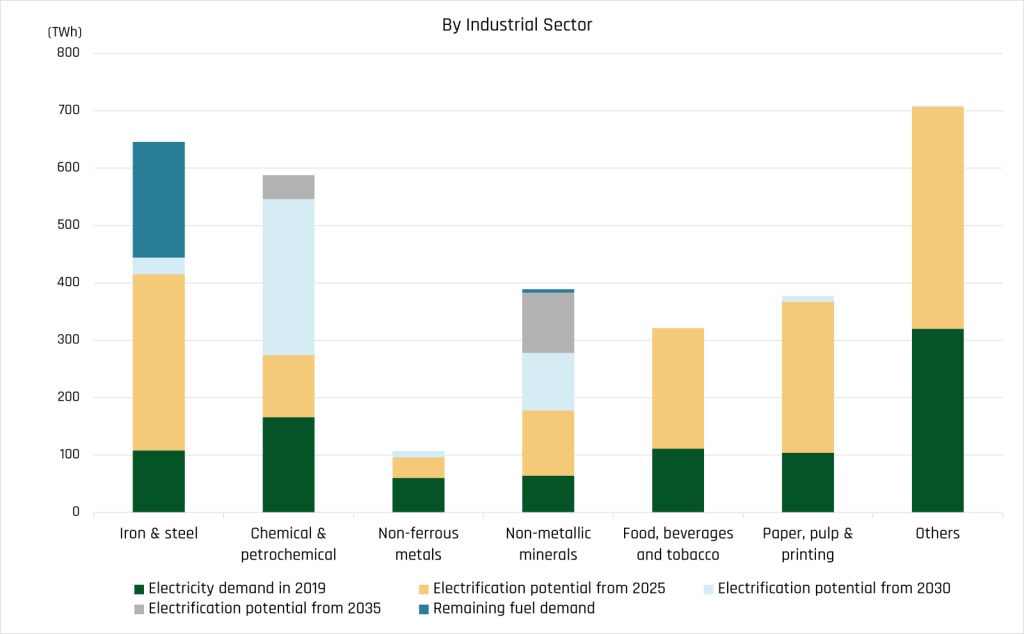While renewable energy and electric vehicles dominate climate conversations, electrifying industrial heat processes could transform 90% of Europe’s industrial energy demand by 2035 using existing technologies. This overlooked transition offers superior efficiency, production quality improvements, and grid balancing capabilities while preserving Europe’s competitive manufacturing edge.
Industrial heat electrification represents an overlooked yet critical pathway to achieving Europe’s climate neutrality and energy independence goals. While renewable energy deployment and electric vehicles attract significant attention, industrial heat electrification in Europe remains in the shadows despite its enormous potential.
Consider this: at the global level, heat is responsible for half of all final energy consumption, representing the single largest energy end use. The industrial sector is particularly heat-intensive, with thermal processes consuming over two-thirds of industrial energy, mostly derived from fossil fuels. Yet research indicates that 60% of Europe’s industrial energy demand could already be electrified using fully developed technologies, with the potential rising to 90% by 2035.
Technical potentials for direct electrification in the EU-27

Source: Fraunhofer ISI (2024), p.10
A Spectrum of Solutions for Every Temperature Need
Electric technologies for industrial heat electrification exist today to cover the entire range of industrial heating requirements, from low-temperature food processing to ultra-high temperature cement production. These aren’t future technologies, they’re market-proven solutions already being deployed across European industries. Examples include:
- Industrial Heat Pumps: Efficiency rates of 150-600%. Currently reach 170°C. Used for food processing and chemicals.
- Electric Boilers: Deliver 500°C heat with 99% efficiency. Easy integration into existing systems. Lower investment costs than heat pumps.
- Plasma Torches: Generate temperatures up to 5000°C. Alternatives to fossil burners for cement and other high-heat processes in European industrial heat applications.

Source: Fraunhofer ISI (2024), p. 12
What Are the Benefits Beyond Emissions Reduction?
- Superior Efficiency: Technologies for industrial heat electrification are inherently more efficient than fossil fuel-based alternatives.
- Higher Quality Production: Electric heating offers more precise temperature control, leading to higher product quality, fewer defects, and faster production times for manufacturers.
- Smart Grid Integration: Electric heating systems can store heat and adjust when they use electricity, helping balance the grid when renewable energy is abundant. This flexibility can even create new revenue opportunities for European industrial users.
The Quantifiable Impact on Europe’s Climate Goals
The scale of emissions reduction through industrial heat electrification represents a significant opportunity for Europe. Current heat pump technology could reduce industrial carbon emissions by up to 146 million tonnes annually—exceeding the Netherlands’ total yearly emissions.
By 2050, implementing heat pumps and electric boilers throughout the EU27 could eliminate approximately 250 million tonnes of CO2 emissions each year. From an energy systems perspective, electrified heating systems coupled with thermal storage can provide grid balancing services, helping to integrate variable renewable energy. By shifting heat production to times when renewable electricity is abundant, industrial facilities can reduce costs while supporting grid stability, creating a practical relationship between industrial operations and the broader energy transition.
Europe’s Competitive Edge in Industrial Heat Electrification
Unlike the solar PV sector where manufacturing has largely shifted to Asia, Europe maintains a strong industrial base in heating electrification technologies. European companies lead in developing and manufacturing advanced industrial heat pump systems and other electric heating technologies.
Breaking Down Financial Barriers to Industrial Heat Electrification
Despite its potential, several barriers have hindered widespread adoption of industrial heat electrification in Europe: unfavourable electricity-to-gas price ratios, technical integration challenges, and organizational constraints.
Heating as a Service (HaaS) business models are emerging as a powerful solution. By eliminating upfront capital investments and technical complexities, HaaS enables industrial facilities to transition to electric heating while preserving capital for core business activities. Under this model, Energy Service Companies design, finance, install, operate, and maintain the electrified heating system, while the industrial customer pays only for the heat consumed at a predetermined rate over a long-term contract.
The Institutional Investment Opportunity
For institutional investors seeking stable, long-term returns with meaningful climate impact, energy efficiency project debt represents a compelling opportunity. These investments offer fixed cash flows through contractual off-take agreements, diversified counterparty exposure across sectors, limited correlation to traditional assets, and security from the essential nature of energy services. Projects align with Article 9 SFDR requirements and EU Taxonomy eligibility, satisfying increasingly stringent ESG mandates €150+ billion annual funding shortfalls for building efficiency improvements.
At Solas Capital AG we provide specialised financing solutions for demand-side energy projects, bridging the gap between institutional investors and high-impact energy efficiency projects. Our investment strategy provides fixed-income like returns, allowing investors to match their liabilities while gaining exposure to investments that feature:
- Long-term contractual cash flows without electricity price risk, typically seen in renewable energy projects
- Diverse counterparty exposure across multiple sectors and hundreds of off-takers
- Limited correlation to traditional asset classes
- Resilience during economic downturns due to the essential nature of energy services
By incorporating energy efficiency alongside renewable energy investments, institutional investors can build more complete and balanced climate-aligned portfolios that simultaneously enhance energy security and economic resilience.
Conclusion: A Critical Pathway Forward
As Europe intensifies its pursuit of climate neutrality and energy independence, industrial heat electrification deserves recognition as a cornerstone of this transformation. The technology is ready, the efficiency gains are substantial, and innovative financing models are removing adoption barriers.
The sleeping giant of Europe’s energy transition is awakening. Those who recognize the potential of industrial heat electrification early will help shape a more sustainable and competitive industrial future.

